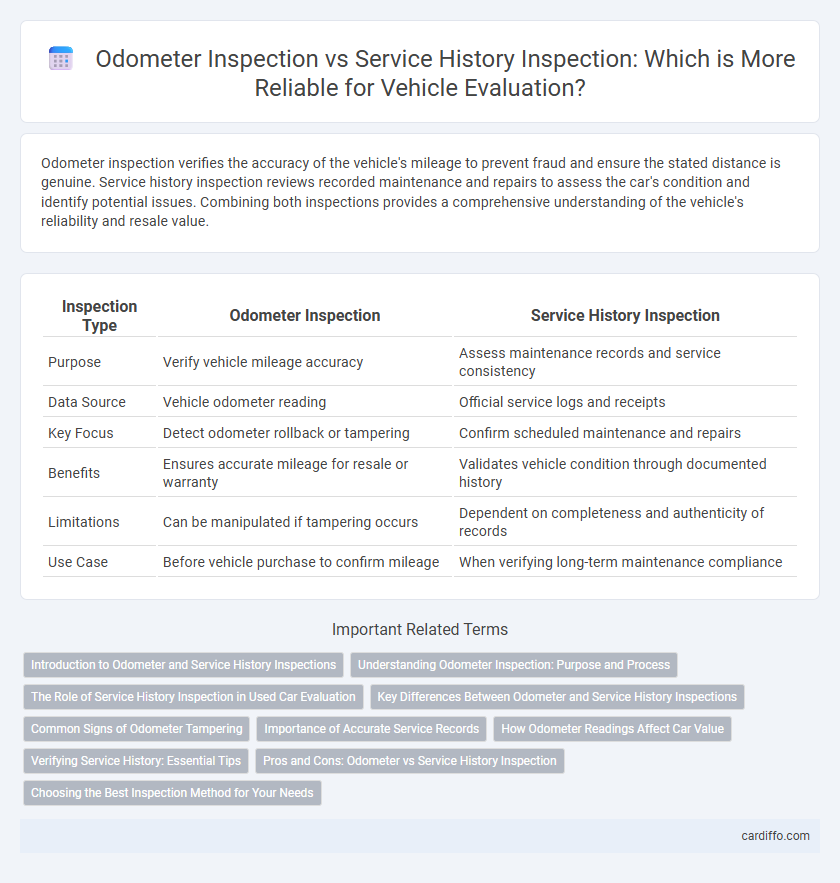Odometer inspection verifies the accuracy of the vehicle's mileage to prevent fraud and ensure the stated distance is genuine. Service history inspection reviews recorded maintenance and repairs to assess the car's condition and identify potential issues. Combining both inspections provides a comprehensive understanding of the vehicle's reliability and resale value.
Table of Comparison
| Inspection Type | Odometer Inspection | Service History Inspection |
|---|---|---|
| Purpose | Verify vehicle mileage accuracy | Assess maintenance records and service consistency |
| Data Source | Vehicle odometer reading | Official service logs and receipts |
| Key Focus | Detect odometer rollback or tampering | Confirm scheduled maintenance and repairs |
| Benefits | Ensures accurate mileage for resale or warranty | Validates vehicle condition through documented history |
| Limitations | Can be manipulated if tampering occurs | Dependent on completeness and authenticity of records |
| Use Case | Before vehicle purchase to confirm mileage | When verifying long-term maintenance compliance |
Introduction to Odometer and Service History Inspections
Odometer inspection verifies the accuracy of the vehicle's mileage to prevent fraud and ensure proper maintenance intervals. Service history inspection involves reviewing documented maintenance records to confirm consistent servicing and detect discrepancies that may affect vehicle value. Both inspections are crucial for assessing a vehicle's condition and verifying its authenticity in resale or purchase transactions.
Understanding Odometer Inspection: Purpose and Process
Odometer inspection verifies the accuracy of a vehicle's mileage reading to prevent fraud and ensure transparency in transactions. This process involves cross-referencing the odometer reading with the service history, maintenance records, and sometimes electronic data stored within the vehicle. Accurate odometer inspections help buyers and sellers assess the true condition and value of the vehicle, protecting against odometer rollback and mileage discrepancies.
The Role of Service History Inspection in Used Car Evaluation
Service history inspection provides critical insights into a used car's maintenance records and overall condition, revealing patterns of regular upkeep and repairs that an odometer alone cannot convey. Unlike odometer inspection, which primarily verifies mileage accuracy, service history inspection offers a comprehensive view of a vehicle's reliability and potential future issues. This detailed maintenance timeline enhances the buyer's confidence by validating the car's mechanical health beyond mere distance traveled.
Key Differences Between Odometer and Service History Inspections
Odometer inspection verifies the accuracy of a vehicle's mileage to detect tampering or rollback, crucial for assessing vehicle value and ensuring transparency. Service history inspection reviews documented maintenance and repairs to evaluate the vehicle's condition, reliability, and adherence to manufacturer recommendations. The key difference lies in odometer inspection focusing on mileage integrity, while service history inspection emphasizes maintenance records and vehicle care.
Common Signs of Odometer Tampering
Common signs of odometer tampering include inconsistent mileage recorded in the vehicle's service history, visible scratches or loose screws around the odometer, and digital odometer readings that fail to align with the car's overall condition. Inspectors often compare the odometer reading against maintenance records, tire wear, and engine hours to detect discrepancies. Identifying these signs is essential to ensure accurate vehicle valuation and trustworthiness in vehicle history reports.
Importance of Accurate Service Records
Accurate service records are crucial in odometer and service history inspections as they verify the true mileage and maintenance consistency of a vehicle, preventing fraud and ensuring trustworthiness. Comprehensive documentation helps inspectors detect discrepancies between reported odometer readings and actual vehicle usage, safeguarding buyers and sellers from potential legal and financial risks. Maintaining reliable service history supports vehicle valuation and enhances transparency in pre-purchase assessments.
How Odometer Readings Affect Car Value
Odometer readings serve as a critical indicator of a vehicle's usage and directly impact its resale value by reflecting wear and tear over time. Accurate odometer inspection ensures that the mileage is genuine, preventing undervaluation or overvaluation in the used car market. Service history inspections complement this by verifying maintenance consistency, but odometer readings remain the primary metric influencing buyer trust and vehicle depreciation rates.
Verifying Service History: Essential Tips
Verifying service history through detailed records ensures accurate odometer readings and detects discrepancies that may indicate tampering or rollback. Cross-referencing maintenance invoices, inspection reports, and service stamps provides a comprehensive understanding of vehicle usage and performance. Inspections that incorporate both odometer verification and service history analysis enhance the reliability of overall vehicle condition assessments.
Pros and Cons: Odometer vs Service History Inspection
Odometer inspection provides a precise measurement of a vehicle's actual mileage, crucial for assessing wear and determining resale value, but it risks tampering and inaccuracies without proper verification. Service history inspection offers comprehensive insights into regular maintenance and repairs, helping predict future issues, yet it depends heavily on the completeness and honesty of records, which can vary widely. Combining both methods enhances reliability by cross-verifying mileage against maintenance events, reducing the chances of fraud or oversight.
Choosing the Best Inspection Method for Your Needs
Selecting the best inspection method depends on the vehicle's condition and the purpose of the evaluation. Odometer inspection provides precise mileage verification to detect tampering, essential for accurate valuation and legal compliance. Service history inspection offers a comprehensive maintenance record, ensuring mechanical integrity and identifying potential future repairs.
Odometer inspection vs service history inspection Infographic

 cardiffo.com
cardiffo.com